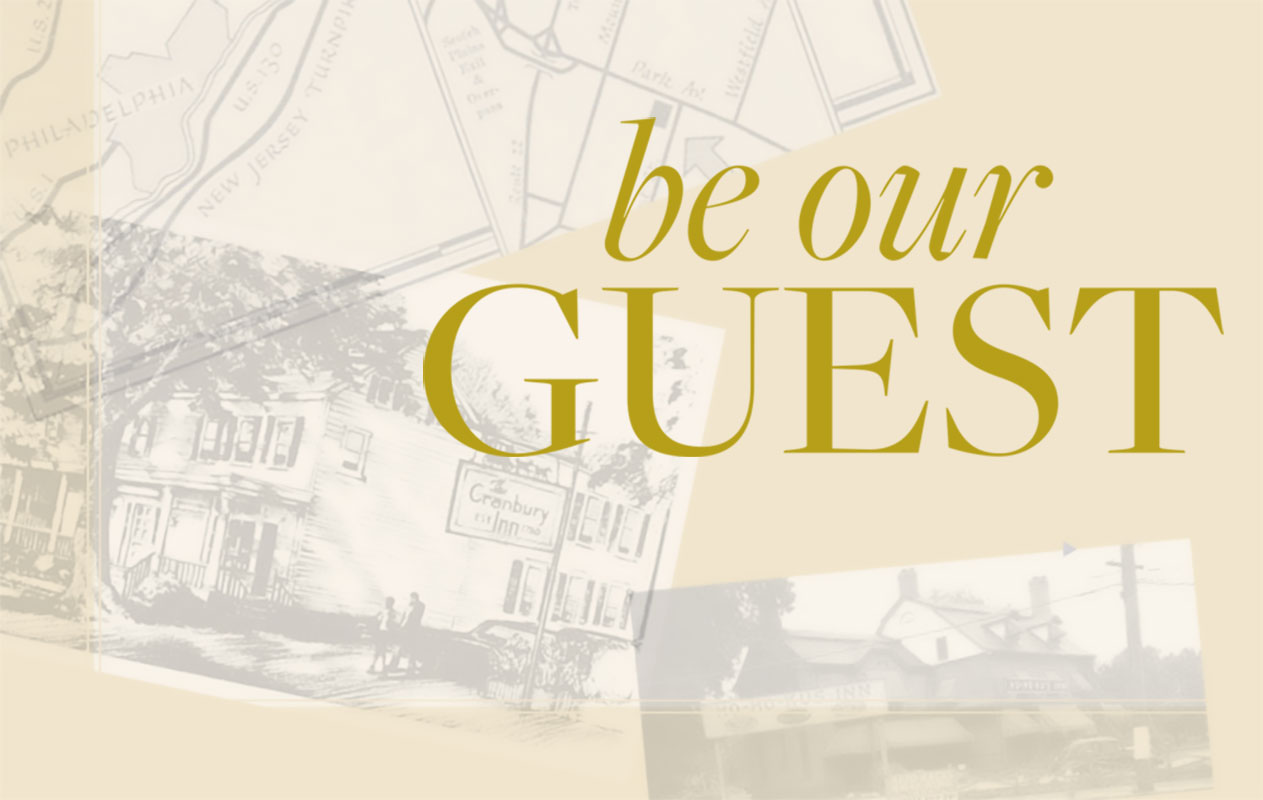Vibrant Flavors and NJ’s Storied Past Meet at New Jersey’s Historic Inns
It all started with a simple question from Jessie Havens, one of our longest- standing members at Preservation New Jersey (PNJ), who wanted to help a friend. Her friend had asked her, and then Jessie asked me: What are some restaurants in historic buildings in NJ?
Without a comprehensive answer, I turned to the crowd, posted online, and a couple hours later the question had gone viral. People from all across the state were sharing their personal favorites, tagging friends, and linking to heritage sites restaurants of choice across New Jersey. The preservation community, it turned out, was thrilled to share and I was well on my way to planning some day trips.
One category of sites that emerged frequently among the recommendations was historic inns. New Jersey, a crossroads for travelers since long before the Garden State Parkway, is dotted with old inns that provided food and board to travelers. The histories of these inns have a lot to teach us about the region’s early industries, yesteryear travel, and various figures and families from New Jersey’s past. Fortunately, due to adaptive reuse, we can still also have some delicious meals along the way.
NATIONAL REGISTER OF HISTORIC PLACES
LAMBERTVILLE HOUSE
30-32 Bridge St., Lambertville
lambertvillehouse.com
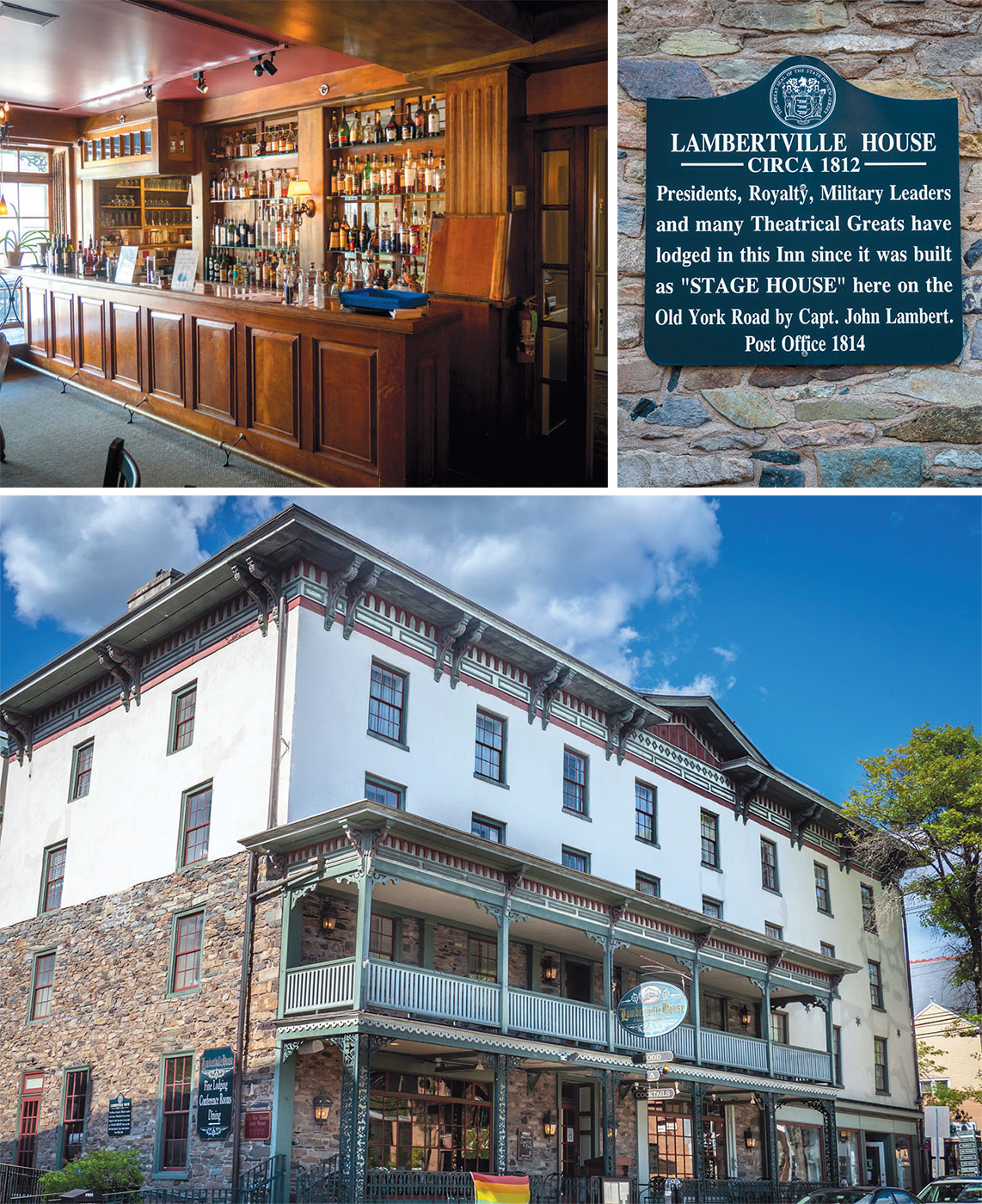
Lambertville House, a striking fieldstone-fronted and balconied inn, is one of the few inns in the state that still operates as an inn in addition to a restaurant. Its founding is tied intricately into the history of its namesake city and its position at the base of a critical piece of early transportation infrastructure: a bridge over the Delaware River.
The city of Lambertville, like much of New Jersey, is located on land previously inhabited by the Lenape. First settled by Europeans in 1705, it was originally named Georgetown. A settler named John Holcombe was largely responsible for Lambertville’s early development and fought to have the main road from New York to Philadelphia pass through the town.
In 1732, Georgetown was renamed Coryell’s Ferry after Emanuel Coryell, who operated a ferry between the city and New Hope on the opposite bank of the Delaware River in Pennsylvania. The town’s new name was a way of promoting the ferry’s important service.
In the early 1800s, a wooden bridge was built across the Delaware to better serve travelers, taking two years to construct at a cost of $69,000. The community was renamed Lambertville in 1810, when the post office was established, in honor of U.S. Senator John Lambert who was responsible for the opening of the post office. In 1812, Captain John Lambert, the Senator’s nephew, erected a “tavern and hostelry” now known as the Lambertville House.
A centerpiece in the heart of modern-day Lambertville, the inn presents an inviting mix of hospitality and historical ambience. “The food at the Lambertville House is delicious and the building is packed with history,” says Elizabeth Horvath, local foodie and owner of Sister City Food & Shop Tours. Horvath recommends trying the “Local Love Menu” which offers three courses for $25 every Monday night. Originally created to show appreciation to the inn’s local customers, the menu attracts both locals and anyone interested in fine Monday night dining. A recent menu featured generous starter course options, including Cream of Asparagus Soup, main courses like Jumbo Lump Crab Cake and a Petite Filet Mignon, and desserts, a difficult choice between chocolate cheesecake, strawberry napoleon, and bread pudding.
NATIONAL REGISTER OF HISTORIC PLACES
HO-HO-KUS INN & TAVERN
1 E. Franklin Turnpike, Ho-Ho-Kus
hohokusinn.com
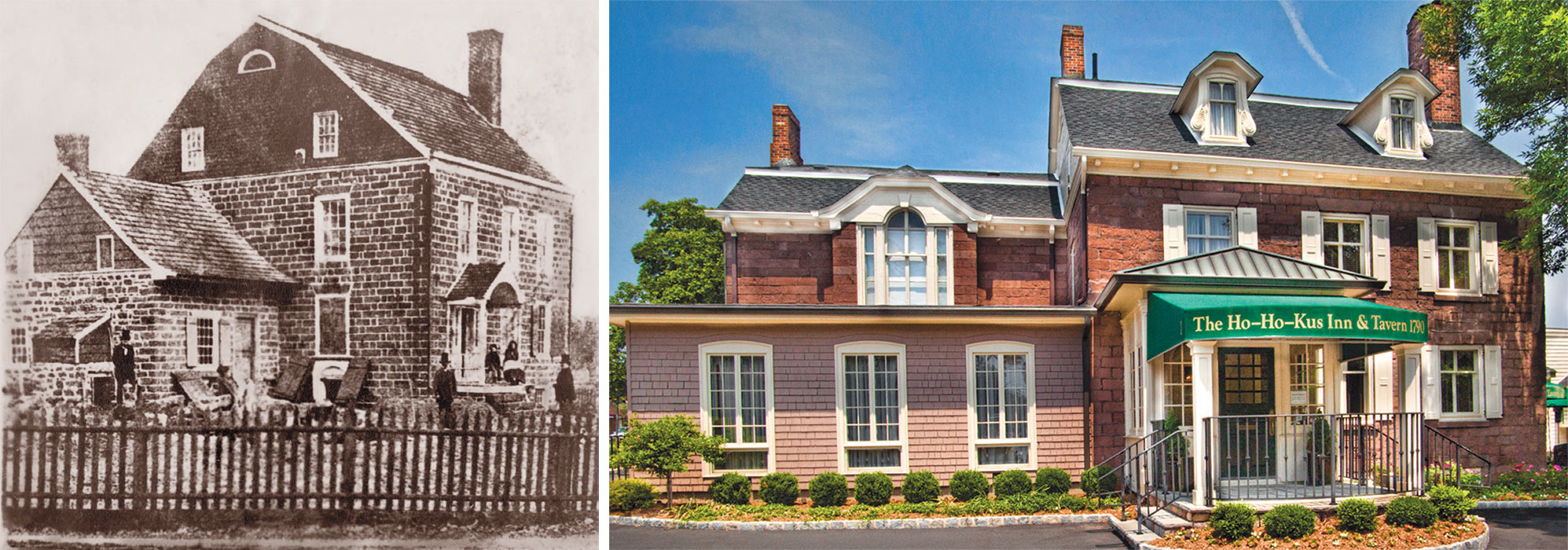
The Ho-Ho-Kus Inn & Tavern has been through almost too many uses to count between its construction in 1796 and its present form today. It was originally built as a house by Andrew Zabriskie for his son John, both descendants of Albert Zabriskie who came to Bergen County in 1662 from Prussia and whose family formed a large part of the county’s early European settlement. Looking at properties owned by the Zabriskie family tell us a lot about Bergen County history. In Paramus, the Zabriskie Tenant House helped tell the oft-overlooked story of slavery in North Jersey and the free, thriving African-American community that existed in the area dating back to the 1830s. (Despite community outcry, the Tenant House property was demolished in 2012.) The restored Zabriskie-Steuben House is open to visitors at Historic New Bridge Landing Park in River Edge, alongside other period structures.
When the property now known as the Ho-Ho-Kus Inn was built, the town was growing with several grist and cotton mills along the Ho-Ho-Kus Brook. In the 1830s, Ho-Ho-Kus became a popular tourism destination as one of the first stops along the newly constructed Erie Railroad that carried travelers between New York City and Albany. More than just a place to rest in the midst of travel, however, the wooded Ho-Ho-Kus became popular with visitors looking to experience the great outdoors. An 1870s Erie Railroad publication called “Where Shall We Spend the Summer?” prominently features Ho-Ho-Kus. A lake named Sylvan Lake (definitely worth researching!) even appeared and disappeared and was enjoyed by visitors in this era.
After a series of owners in the Zabriskie family, and then others who turned it into an inn, the town bought the building and property in 1941 to preserve it. It was sold in 2009 to Gordon and Laurie Hamm, Ho-Ho-Kus residents and longtime admirers of the inn who undertook a $1.5 million renovation.
Beyond offering a unique, history-packed building, under Gordon and Laurie’s leadership today the Ho- Ho-Kus Inn hosts a vibrant restaurant and offers creative events like The Ho-Ho-Kus Inn’s Cellar Club, a wine education series that involves a flight of four wine tastings with complimentary food course pairings. A recent Cellar Club event featuring wines rated 90 points and above by Wine Spectator, for example, paired Albert Bichot Pouilly-Fuisse 2017 with an Arugula and White Bean Salad, a Stoller Pinot Noir 2017 with Butternut Squash Ravioli, Carpineto Chianti Classico Riserva 2015 with Short Rib Ragu and a Substance Cabernet Sauvignon Washington 2017 with a Chocolate Pecan Tart.
NATIONAL REGISTER OF HISTORIC PLACES
STAGE HOUSE TAVERN
366 Park Ave., Scotch Plains
stagehouse-sp.com
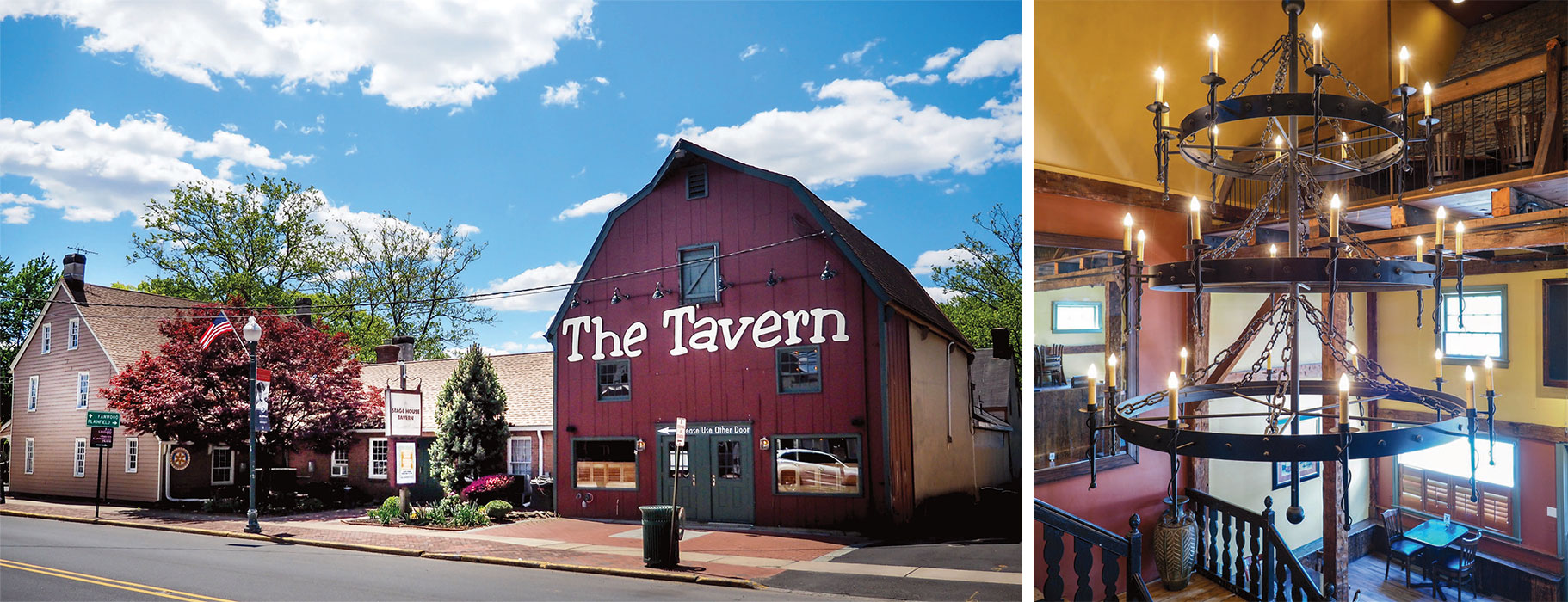
Spread across several historic buildings, the Stage House Tavern offers a comfortable dining experience with meaningful homages to the building’s long past. Several private dining rooms host original fireplaces; a small area covered by glass in the modern, crisp dining room on the second floor allows visitors a view of the original walls. Restored original beams show overhead.
The Stage House Tavern was first opened by John Sutton in 1737 as the Stage House Inn. Its website, packed with history and even information on historic restoration, puts this time period into context well: “When the Stage House opened, there was no such thing as the State of New Jersey; and the residents living in the ten houses that made up the Village of Scotch Plains were subjects of the British Crown.”
Similar to all the inns discussed so far, the location on a key travel route allowed this inn to thrive. The Old York Road running from Elizabethtown (present-day Elizabeth) to Lambertville regularly carried stagecoaches from New York to Philadelphia, and Sutton’s Tavern became a regular stop on the “Swift- Sure Stage Line.”
According to Stage House General Manager Matt Dudek, the building’s long history is a point of pride. “The Stage House has been an integral part of the Scotch Plains community for four centuries. It bore witness to Revolutionary battles and heard cries for social and national unity by Abraham Lincoln,” he says. “Through all of American history, Stage House has maintained itself as a cornerstone of our community. We gladly carry on that history today.”
Tom Strowe, the redevelopment manager for the Borough of Scotch Plains, agrees. “The Stage House is one of the historic treasures in Scotch Plains that connects us with our rich historic past going back to the Revolutionary War. Historic figures such as General Lafayette and General George Washington were at the Stage House. [Today] with excellent food and drinks, live music, DJ nights, trivia nights, and more, the Stage House is one of the happening places in town.”
Dining there recently, our group enjoyed the Fried Goat Cheese Ravs with spicy tomato sauce, Marinated Steak Sandwich, Tavern Meatloaf, and a Parm Chicken Pie thin crust pizza. With a huge, comfortable outdoor space and long slate bar, this will be a go-to for us in the summer months.
NATIONAL REGISTER OF HISTORIC PLACES
THE CRANBURY INN
21 S. Main St., Cranbury
thecranburyinn.com
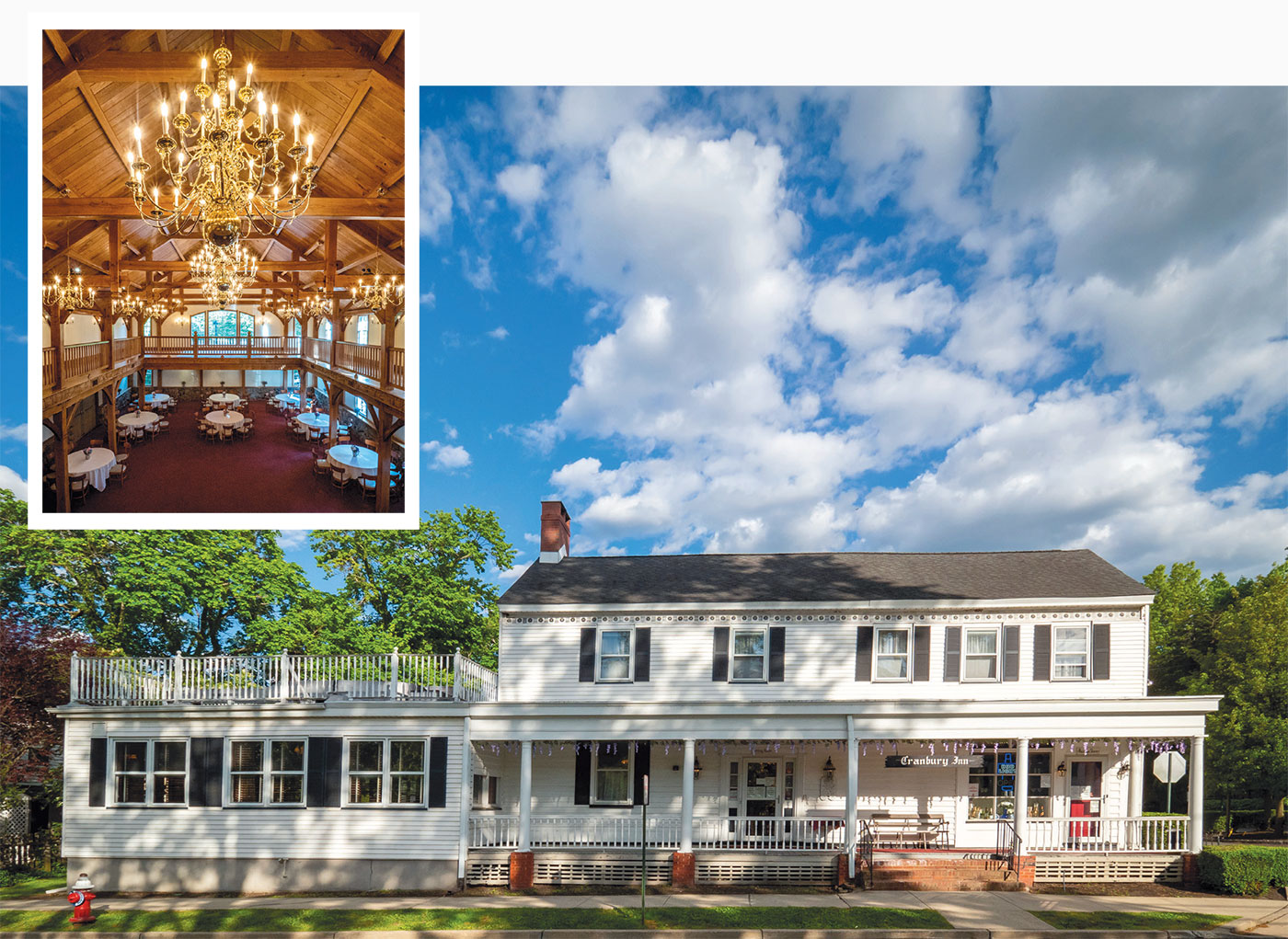
The story of the Cranbury Inn begins in the 1700s when the area’s first roadways began to develop along a Lenni Lenape trail. That trail widened into a road connecting Philadelphia and New York. The journey took three days and Cranbury, in the middle, became a natural stopping point. As the trail became a main thoroughfare for colonial travelers, the town of Cranbury developed. Two separate taverns were built to serve travelers and were later combined into the Cranbury Inn.
The grandson-in-law of one of the tavern’s early owners Rev. William S. Hall, a Quaker and a declared abolitionist, led the Cranbury Inn to become a documented stop on the Underground Railroad*. Individuals escaping from slavery were brought to the inn from nearby Crosswicks or Allentown and housed before being moved north to New Brunswick. When Enoch Middleton wrote about the experience of being an agent on the Railroad 30-40 years after this activity had ceased, he recalled that “he kept enough to make a load and under the cover of darkness he would load them into his wagon and take them to Cranberry, the next stop on the road to freedom in Canada.”
Today, one of the highlights for diners at the Cranbury Inn is a Champagne Brunch on Sundays followed by Sunday Dinner. The property also offers several unique buildings and private areas on site to host functions for 200+ guests. On the menu, the house specialty is the Cranbury Inn Crab Cake featuring Maryland crab meat served with an herb sauce au beurre blanc.
Founded in 1978, Preservation New Jersey, a nonprofit historic preservation organization, promotes the economic vitality, sustainability, and heritage of New Jersey’s diverse communities through advocacy and education. preservationnj.org
*Steal Away, Steal Away: A Guide to the Underground Railroad in New Jersey, published 2002 by the New Jersey Historical Commission, and written by Giles Wright.
MORE HISTORIC INNS
to visit & dine at
FRANKLINVILLE INN
2526 Delsea Dr., Franklinville
franklinvilleinn.com
The Franklinville Inn is not listed on the National Register of Historic Places, but it is historic. In the Colonial days, what is now Delsea Drive was a stagecoach route from the Delaware River to the sea and the Franklinville Inn provided a place to rest and eat. Today this Gloucester County inn has been called a “Best Kept Secret” by the Courier-Post and rated one of the top 100 restaurants in America by OpenTable.
FRENCHTOWN INN
[National Register of Historic Places]
7 Bridge St., Frenchtown
frenchtowninn.com
The Frenchtown Inn is a stately building with a wide, sweeping porch right on the Delaware River. Founded in 1838, it was originally called “Railroad House,” in anticipation of the Phillipsburg-to-Trenton rail line that would open through Frenchtown 15 years later. People rave about dining on the porch while enjoying desserts like the crème brulee, and the inn’s expansive bar is a favorite stop for modern-day visitors.
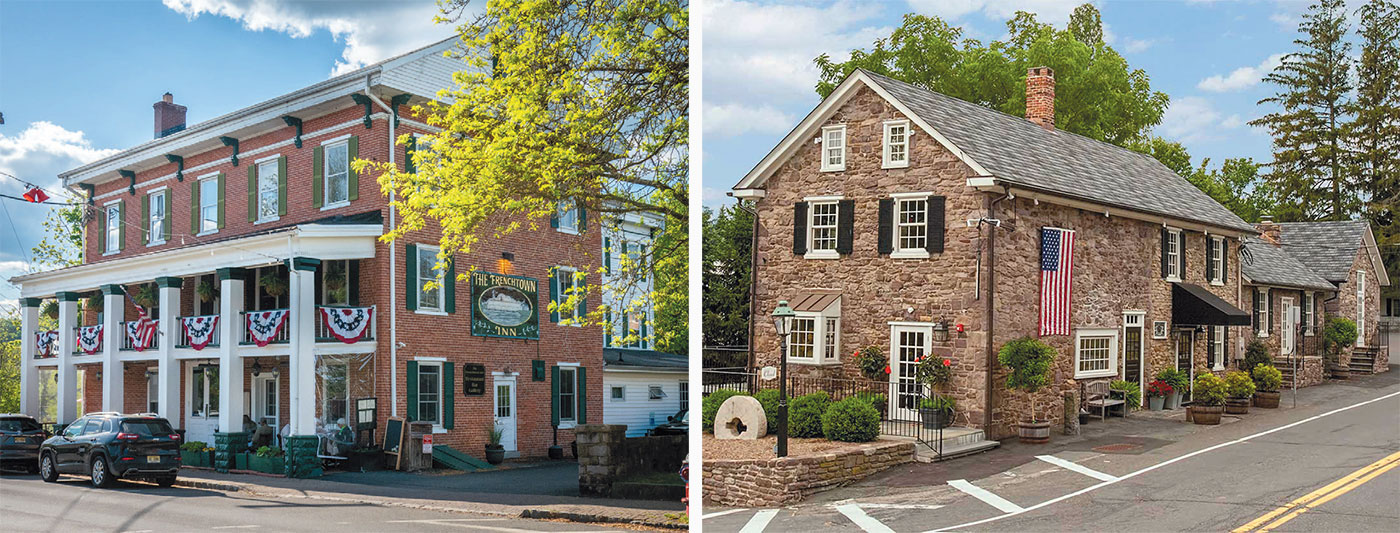
Left: Frenchtown Inn; Right: Sergeantsville Inn
SERGEANTSVILLE INN
[National Register of Historic Places]
601 Rosemont Ringoes Rd., Sergeantsville
sergeantsvilleinn.com
Fun fact: Not originally an inn! This gorgeous stone structure, part of the Sergeantsville Historic District, was a grain and feed store, then a grocery store, then an ice cream parlor, and even a pelt trading center. Today it is one of New Jersey’s most outstanding farm-to-table restaurants that, according to a recent Yelp reviewer, ranks “in the top 5 restaurants on the planet.”
STANHOPE HOUSE
45 Main St., Stanhope
stanhopehousenj.com
The Stanhope House, “The Last Great American Roadhouse,” truly rocks. Since its founding in 1794, it has hosted musicians like Muddy Waters, Johnny Copeland, and, more recently, Rakim and KRS-One. Beyond the draw of the music, however, is a great kitchen, serving up pub favorites like ‘The Fabulous Thunderbird” chicken sandwich and Roadhouse Burger in a no-frills atmosphere.
YE OLDE CENTERTON INN
1136 Almond Rd., Pittsgrove
centertoninn.com
Ye Olde Centerton Inn has been in continuous operation since 1706, making it the oldest continually operating inn in New Jersey. Online reviewers repeatedly cite the seafood bisque as a must try and note the great service.


